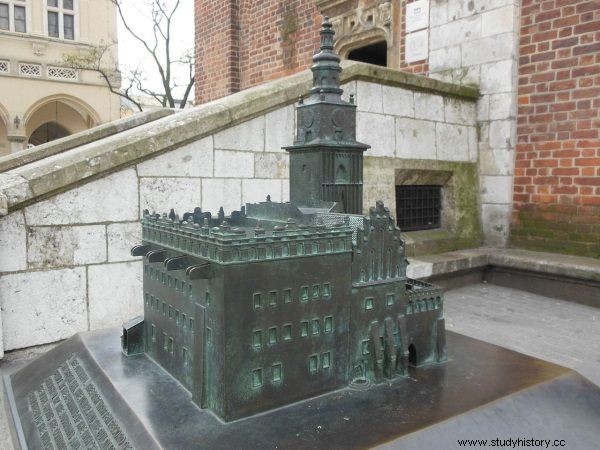Almost every self-respecting city and town has a town hall. Wrocław, Poznań, Tarnów or even Głogów Małopolski have it. Only in the former capital, the royal city of Krakow, it is not possible to find a historic town hall by a strange coincidence. Only a lonely tower has survived in the market square. Why?
Let's start with the obvious. Of course, there used to be a town hall on the market square in Kraków, and even several town halls. The only thing that is known about the oldest is that it was wooden and probably burned down in the fourteenth century, in 1306 to be exact. Another one certainly existed in 1316, but relatively quickly it turned out to be too small for the needs of the developing city. Finally, the Krakow authorities decided to build a stately headquarters corresponding to their rank.
It was completed in 1414. The town hall, which was built at that time, turned out to be an extremely lucky building. Although fires consumed the city many times, and the town hall tower required numerous renovations, the seat of the local government itself survived over four hundred years.

Town Hall in the mid-seventeenth century. Reconstruction made by the Historical Museum of the City of Krakow.
Strangely, the way in which it disappeared from the face of the earth is ignored or completely ignored by most books devoted to the monuments of Krakow. Their authors usually limit themselves to a short mention:the town hall was demolished shortly after the fall of the Polish-Lithuanian Commonwealth, during the partitions. From this the readers draw a simple conclusion that apparently it was the lousy invader who demolished the Polish monument and the reason for pride of the Cracovians. Well, there is no truth in that.
Krakow City Hall. It was not the partitioner's doing
After the city was seized in 1796, the Austrians decided to convert the town hall into government administration offices. The architect they employed drew up plans for the town hall and a design for its reconstruction. As Michał Grabowski writes in the museum guide devoted to the town hall tower, the new hosts considered the possibility of restoring the town hall in order to use it as the seat of their authorities.

Right next to the tower, which is the only fragment of the town hall that has survived, there is a small reconstruction of the appearance of the building. (license of CCA-SA, author:Mach240390).
The plans never came to fruition, because the partitioning power did not last long. In 1809, Krakow became part of the Duchy of Warsaw established by Napoleon, and in 1815 it became a Free City.
For the first years, the so-called Republic of Kraków enjoyed real independence in internal affairs, and it was the inhabitants of Kraków themselves who made decisions concerning urban affairs. The then fate of the town hall in 1906 was described in Józef Muczkowski in the "Annual Cracow". 
On March 1, 1817, the Assembly of Representatives of the Free City of Krakow passed the law to demolish selected public buildings. At first glance, the rules seem completely understandable. Lawmakers argued:
Given that in the number of (...) public buildings there are some utterly devastated buildings, the raising of which would require a considerable cost and, if they could not be used for government purposes, an expense corresponding to this must be demolished and the yards sold .
The whole hitch was hidden in the second article:
Because a part of the building called the old town hall, called the granary for a long time, has been turned, because it is in a desolate state:these, therefore, the granaries are to be demolished.
The law on the destruction of the town hall was adopted unanimously , without any objections or votes against. The discussion on this topic took place in the city, but in an unexpected way for us. There were popular calls to dismantle any old, archaic buildings - getting rid of even the town hall would free the city from this "hovel", "disfiguring" the square .

View of the town hall before its demolition, from the east (illustration from the "Yearbook of Krakow", 1906).
Initially, it was planned to demolish only the granaries adjacent to the main building of the town hall, but the prevailing atmosphere did its job. When work finally began in 1820, everything except the tower was razed to the ground. The latter was also seriously threatened. In 1821, one of the senators of the Free City, the name of Soczyński, called in the pages of "Pszczółka Krakowska" to further beautify downtown. He advised to destroy this lonely clock gothic, which in itself is of little value, cannot remain .
In the second half of the nineteenth century, the importance of history and monuments was finally noticed, but earlier decisions could not be undone. It was thought, however, of building a new town hall or some other building in its place. For example ... the theater. In the end, nothing came out of these plans, and Krakow remained one of the few examples of a city without a town hall. The same is true in Warsaw, but that's a completely different story…
Sources:
Basic:
- Józef Muczkowski, The former Kraków Town Hall , "Rocznik Krakowski", vol. VIII (1906), pp. 6-55.
Complementary:
- Michał Grabowski, Town Hall Tower , Historical Museum of the City of Krakow, 2008.
- About the old and today's town hall and about the souvenirs of the Krakow municipal commune , "Time", August 1, 1866.
- "Pszczółka krakowska", 1821.
